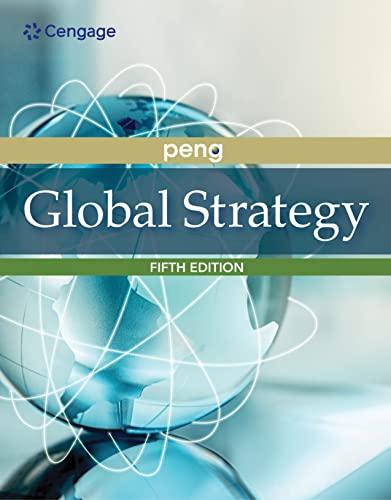Question
Ruby Shelton is part of the executive development training program. As part of her executive development plan, Ruby has temporarily been assigned to the transportation
Ruby Shelton is part of the executive development training program. As part of her executive development plan, Ruby has temporarily been assigned to the transportation division of Whipple Logistics Company. The objective is to expose her to different parts of the company as a method of grooming her for a senior position someday.
Ruby is excited about the opportunity. Her background is in operations management, therefore, she is familiar with transportation requirements, although not an expert. Doreen Delgado is Ruby's mentor in the program. Doreen is a senior vice president and participated in the program when she was a junior executive. She understands the value of such a learning experience.
Whipple Logistics Company has several new clients who want a briefing on the best mode of transportation for their businesses. Doreen assigned Ruby to this project. Doreen believes this is the perfect instrument to help Ruby develop a deep appreciation of the importance of selecting the best mode of transportation for specific products. Ruby is to prepare the briefing for the new clients.
Ruby understands that this is a great opportunity to learn more about Whipple's clients' needs. Her research illustrates that the best mode of transportation often depends on the industry using it. Industries that deal in bulk products such as corn, soybeans, wheat, cement, crude oil, and coal must decide which mode of transportation is best. That decision is often based on the distance over which the shipment must be moved. Trucks have a cost advantage for short distances up to 500 miles; consequently, they function primarily as the short haul option. As the distance increases, rail has a cost advantage over trucks; however, barges have the greatest cost advantage if a waterway connects the point of origin and the destination.
Although Whipple Logistics Company provides shipping services to all industries, the new clients were primarily shipping large bulk items. For bulk shipments barges are the least expensive mode of transportation. However, waterways do not go everywhere; consequently, the critical factors are the shipment origin and its proximity to navigable waterways.
Ruby began to investigate what besides cost could be a driving factor. She discovered that seldom were single barges alone used to haul cargo. Generally, barges are cabled together in what is called a 15-barge tow, giving it a capacity of 22,500 tons. Ruby wondered how this compared to the capacity of rail and trucks. She knew that rail cars are also connected together to increase capacity. The standard is a 100-car train whose hauling capacity is 11,200 tons; thus, it takes two 100-car trains to match a 15-barge tow. A third option is semitrucks or "18-wheelers." A single semitruck can haul 26 tons. Unfortunately, the drawback of semitrucks is they are a single shipping system, unlike barges or rail cars that are combined to create a larger shipping system. Approximately 870 semitrucks would be required to equal the cargo capacity of either a 15-barge tow or two 100-car trains.
Ruby decided that barges are the best bulk transportation option, if the origin and destination can be accessed by water. She appreciated that it was more complex that just cost though. One needs to factor in possible delays due to weather and the hauling capacity of a specific mode of transportation.
Question
1. How should Ruby approach this briefing? Should she explain each type or should she discuss only the concept of intermodal transportation? Explain your recommendation; why do you think one approach is better than another, that is, what is the benefit to those being briefed?
2. In your opinion, which mode of transportation has the most potential for problems? Explain why you say that.
3. Identify the mode of transportation that is the most flexible and the one that is the least flexible. Explain why you consider them as the most and least flexible.
Step by Step Solution
There are 3 Steps involved in it
Step: 1
1 In approaching the briefing for the new clients on the best mode of transportation for their busin...
Get Instant Access to Expert-Tailored Solutions
See step-by-step solutions with expert insights and AI powered tools for academic success
Step: 2

Step: 3

Ace Your Homework with AI
Get the answers you need in no time with our AI-driven, step-by-step assistance
Get Started


